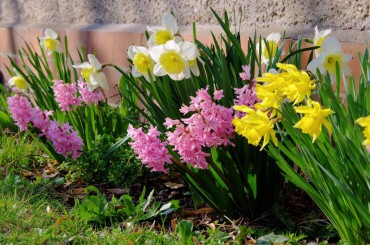There’s still time to plant bulbs, whether it’s directly into the garden or into containers.
Bulbs are one of the easiest things to plant and then not much work to do after that. If you choose the correct kinds of bulbs, they’re also the gift that keeps on giving.
Generally you’ll have the opportunity to plant bulbs twice a year. Plant bulbs such as snowdrops, tulips and daffodils in October and November for spring blooms (anywhere from February through May). Plant bulbs (actually corms and rhizomes) such as gladiolas, iris, crocosmia and begonias in March through May for summer blooms.
Remember: If you can plant them in the ground, you can also easily plant bulbs in containers of all shapes and sizes.
Most bulbs come with instruction sheets. The general rule of thumb is to cover the bulbs with soil two to three times taller than the bulb itself. For example, if the bulb is 1 inch tall, then you’d cover it over with 3 inches of soil.
Bulbs are an amazing, self-contained plant-energy packet. Everything the plant needs is contained in the bulb itself. If you look closely, you’ll see the bottom where last year’s roots were and the tops are usually more pointy (where the stem and flower used to be).
 Just remember: Pointy end up and flatter end down.
Just remember: Pointy end up and flatter end down.
When you dig the hole directly in the soil, if the hole is filled with water, do not plant there. Bulbs need good drainage.
When planting in a container, first put a layer of soil on the bottom of the container and then work your way up to the top, layering in bulbs and soil. Start with larger bulbs on the bottom and finish up with the smallest bulbs on the top, or plant the container with only one type of bulb. It’s your choice.
When the containers have died back down after blooming, put them in a holding area of your garden so the foliage can die back naturally. The dying foliage is actually being absorbed by the bulb to make all the energy for another time of foliage and flowers the next year.
You can also remove the bulbs from the containers and plant them directly into your garden. Either way, you’ll need to let the foliage die back completely before trimming it off and composting it.
Note: When choosing tulips, use species tulips rather than the hybrid variety. Many hybrid varieties behave like annuals. They don’t continue or don’t flower again, or you’ll have to wait several years before the tulips rebloom.
Species tulips sprout and flower every year. With hybrid tulips, the original bulb goes away and leaves behind daughter bulbs that are very small. They take several years to become plump again and work their way up near the top of the soil to grow leaves and blooms again.
If your favorite nursery or garden center has sold out bulbs already, don’t despair. Those same venues often have already planted-up containers of bulbs to purchase and enjoy each spring and summer.
Buy them as soon as you see them and then follow the same process described above for getting more than one year of enjoyment from your purchase.






















Comments